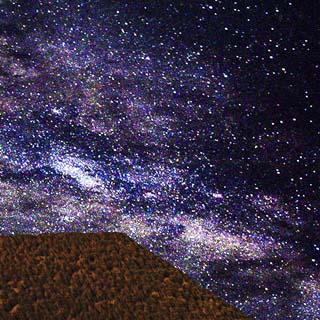MIAS education: the journey to heaven
Course 1 | Course 2
“The voyage by Him in Him”
Exploring the nocturnal journey of the Prophet Muhammad in The Secrets of Voyaging

Credit: NWhitten1776 / Wikimedia Commons / CC BY-SA4.0 /
From: Capulin Night Sky.jpg.
Contact details
Course details
Thinking about trying a course before signing up? To get a taste of this course, please email us education.uk@ibnarabisociety.org
Course overview
In this course we will explore the multi-layered meanings of the Prophet’s journey in The Secrets of Voyaging and the ways in which the Prophet was shown these ‘signs’. In addition to reading excerpts from The Secrets of Voyaging, the voyagers will be invited to read an excerpt from Ibn Arabi’s Kitab Al Isra (especially translated for this course).
Learning Aims and Outcomes
Course learning aims
- Identify the key aspects of the Prophet’s journey.
- Develop a familiarity with Ibn Arabi’s central concepts such as the journey and crossing (ma’bar).
- Explore the meanings of servanthood.
Course outcomes
Upon completion of this course, you can achieve any of the possible outcomes below:
Methodology
Creativity is integral to the human being. Undeniably, our imagination is a force that impacts our daily life. The notion of imagination occupies a significant position in Ibn Arabi’s teachings since the Divine Imagination constitutes the very force that inspired the Great Master’s works. As Henry Corbin succinctly puts it: “To the initial act of the Creator imagining the world corresponds the creature imagining his world, imagining the worlds, his God, his symbols.” Such a correlation between the Divine act of creation and His creatures is an open invitation to those who wish to explore the realm of imagination. Thus, in this course, we invite you to dive into Ibn Arabi’s world of imagination. You will have the opportunity to connect your appreciation of Ibn Arabi’s text with your own creative expression such as poetry, writing, storytelling, drawing, painting and music etc. Such an interaction echoes James Morris’ observation on “the remarkably active approach which Ibn Arabi expects and constantly demands of his truly qualified and spiritually ‘ambitious’ readers, those who begin to interact with his work with the appropriate intentions and preparation.” (source: https://ibnarabisociety.org/how-to-study-the-futuhat)
Instructional strategies
Instructional strategies include mini-lectures, shared reading, creative forms of expression and group discussions.
More journeys
More courses

